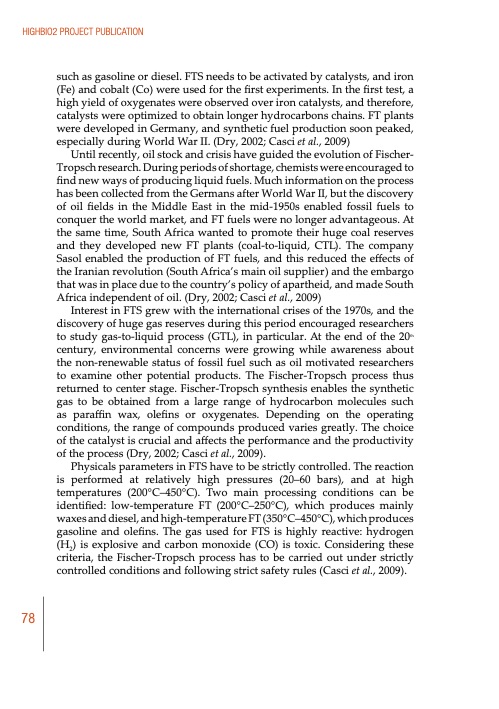
PDF Publication Title:
Text from PDF Page: 079
HIGHBIO2 PROJECT PUBLICATION such as gasoline or diesel. FTS needs to be activated by catalysts, and iron (Fe) and cobalt (Co) were used for the first experiments. In the first test, a high yield of oxygenates were observed over iron catalysts, and therefore, catalysts were optimized to obtain longer hydrocarbons chains. FT plants were developed in Germany, and synthetic fuel production soon peaked, especially during World War II. (Dry, 2002; Casci et al., 2009) Until recently, oil stock and crisis have guided the evolution of Fischer- Tropsch research. During periods of shortage, chemists were encouraged to find new ways of producing liquid fuels. Much information on the process has been collected from the Germans after World War II, but the discovery of oil fields in the Middle East in the mid-1950s enabled fossil fuels to conquer the world market, and FT fuels were no longer advantageous. At the same time, South Africa wanted to promote their huge coal reserves and they developed new FT plants (coal-to-liquid, CTL). The company Sasol enabled the production of FT fuels, and this reduced the effects of the Iranian revolution (South Africa’s main oil supplier) and the embargo that was in place due to the country’s policy of apartheid, and made South Africa independent of oil. (Dry, 2002; Casci et al., 2009) Interest in FTS grew with the international crises of the 1970s, and the discovery of huge gas reserves during this period encouraged researchers to study gas-to-liquid process (GTL), in particular. At the end of the 20th century, environmental concerns were growing while awareness about the non-renewable status of fossil fuel such as oil motivated researchers to examine other potential products. The Fischer-Tropsch process thus returned to center stage. Fischer-Tropsch synthesis enables the synthetic gas to be obtained from a large range of hydrocarbon molecules such as paraffin wax, olefins or oxygenates. Depending on the operating conditions, the range of compounds produced varies greatly. The choice of the catalyst is crucial and affects the performance and the productivity of the process (Dry, 2002; Casci et al., 2009). Physicals parameters in FTS have to be strictly controlled. The reaction is performed at relatively high pressures (20–60 bars), and at high temperatures (200°C–450°C). Two main processing conditions can be identified: low-temperature FT (200°C–250°C), which produces mainly waxes and diesel, and high-temperature FT (350°C–450°C), which produces gasoline and olefins. The gas used for FTS is highly reactive: hydrogen (H2) is explosive and carbon monoxide (CO) is toxic. Considering these criteria, the Fischer-Tropsch process has to be carried out under strictly controlled conditions and following strict safety rules (Casci et al., 2009). 78PDF Image | BIOMASS TO ENERGY AND CHEMICALS HighBio2 Project Publication

PDF Search Title:
BIOMASS TO ENERGY AND CHEMICALS HighBio2 Project PublicationOriginal File Name Searched:
978_951_39_5455_0.pdfDIY PDF Search: Google It | Yahoo | Bing
NFT (Non Fungible Token): Buy our tech, design, development or system NFT and become part of our tech NFT network... More Info
IT XR Project Redstone NFT Available for Sale: NFT for high tech turbine design with one part 3D printed counter-rotating energy turbine. Be part of the future with this NFT. Can be bought and sold but only one design NFT exists. Royalties go to the developer (Infinity) to keep enhancing design and applications... More Info
Infinity Turbine IT XR Project Redstone Design: NFT for sale... NFT for high tech turbine design with one part 3D printed counter-rotating energy turbine. Includes all rights to this turbine design, including license for Fluid Handling Block I and II for the turbine assembly and housing. The NFT includes the blueprints (cad/cam), revenue streams, and all future development of the IT XR Project Redstone... More Info
Infinity Turbine ROT Radial Outflow Turbine 24 Design and Worldwide Rights: NFT for sale... NFT for the ROT 24 energy turbine. Be part of the future with this NFT. This design can be bought and sold but only one design NFT exists. You may manufacture the unit, or get the revenues from its sale from Infinity Turbine. Royalties go to the developer (Infinity) to keep enhancing design and applications... More Info
Infinity Supercritical CO2 10 Liter Extractor Design and Worldwide Rights: The Infinity Supercritical 10L CO2 extractor is for botanical oil extraction, which is rich in terpenes and can produce shelf ready full spectrum oil. With over 5 years of development, this industry leader mature extractor machine has been sold since 2015 and is part of many profitable businesses. The process can also be used for electrowinning, e-waste recycling, and lithium battery recycling, gold mining electronic wastes, precious metals. CO2 can also be used in a reverse fuel cell with nafion to make a gas-to-liquids fuel, such as methanol, ethanol and butanol or ethylene. Supercritical CO2 has also been used for treating nafion to make it more effective catalyst. This NFT is for the purchase of worldwide rights which includes the design. More Info
NFT (Non Fungible Token): Buy our tech, design, development or system NFT and become part of our tech NFT network... More Info
Infinity Turbine Products: Special for this month, any plans are $10,000 for complete Cad/Cam blueprints. License is for one build. Try before you buy a production license. May pay by Bitcoin or other Crypto. Products Page... More Info
| CONTACT TEL: 608-238-6001 Email: greg@infinityturbine.com | RSS | AMP |